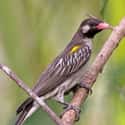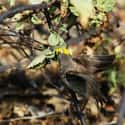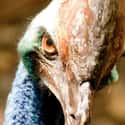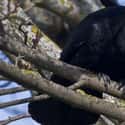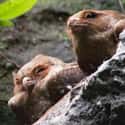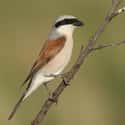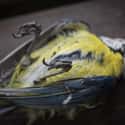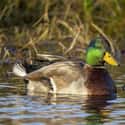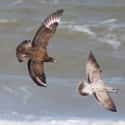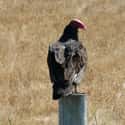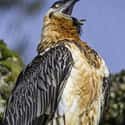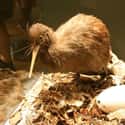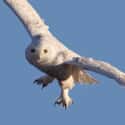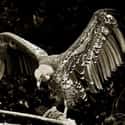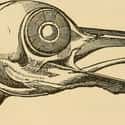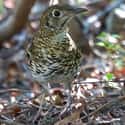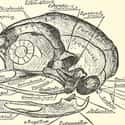-
(#1) The Greater Honeyguide Is A Born Killing Machine
The cuckoo is strange and diabolical enough in that it actually lays its eggs in another bird's nest so that its chick will be fed by the other mother bird, growing bigger and faster while the other chicks in the nest slowly die. However, the greater honeyguide takes it a step further: its chick is born in another bird's nest just like the cuckoo, but the honeyguide has a much shorter game plan in mind.
These chicks are born with a specialized beak sporting spikes at the tip. When the baby honeyguide finds other babies in the nest, it goes about systematically and violently killing them with this specialized beak. It stabs, chews, shakes, and does not stop until the victim stops moving. It will kill all the other chicks in the nest within an hour. Later, the baby's hook simply falls off the beak, its purpose served. In short, this baby bird is adapted perfectly to kill other chicks.
-
(#2) The Vampire Finch Survives On Blood
There are a few birds out there that are somewhat carnivorous, but few are as creepy as the vampire finch. These small birds live in the Galápagos, and feed in large part on the blood of other animals, including threatened blue-footed boobies. They peck at other birds until they bleed, and then they drink the blood as it flows. Weirdly enough, the blue-footed boobies don't seem to mind much, though we're not sure why. Other similar finches prefer to pick parasites off of other animals for nutrients, but the vampire finch has evolved to pecking past just the skin.
As an added creepy factor, it's also been shown that once a finch finds a victim they enjoy, they will actually return to the same animal multiple times to continue to feed. So, if a vampire finch decides you taste good, it'll be coming back for seconds.
-
(#3) Cassowaries Can Kill People
There is often a comparison drawn between birds and dinosaurs, and perhaps no creature embodies a modern-day dinosaur better than a cassowary. These Australian birds are brightly colored and have bony-looking heads in addition to massive clawed feet. In some cases, a cassowary's kick has broken bones, killed dogs, or just ripped into human flesh. But in 1926, the unthinkable happened. Philip and Granville McLean, a pair of teenage brothers, came across a cassowary and their dog attacked it. Granville was gravely injured, and as Philip tried to run away he fell. The bird attacked him, severing an artery in his neck with its feet. The boy bled to death quickly.
Luckily, cassowaries are unlikely to attack you unless you mess with them. Research has shown that the vast majority of attacks were caused because humans provoked the birds, tried to hurt them, or offered them food. In other words, leave them alone, and they won't kick-stab you in the neck.
-
(#4) More Than 10% Of Bird Species Are Endangered
Perhaps one of the saddest frightening facts about birds is that they are a dwindling group of animals. In 2016, 13 bird species were declared extinct, and many are still headed in that direction. The IUCN has recognized 742 bird species in recent years, and at least 11% of those species have been found to be threatened or endangered. This has to do with illegal trade, unsustainable agriculture, and even destruction of habitat and invasive species edging them out. There are around 10,000 known species of birds in the world, and well over 1,000 of them are endangered or threatened. That's about 12%, and that number may continue to grow in coming years. So, even if you find a bird creepy or scary, remember that the world would be a much more scary place without them.
-
(#5) If You Mess With A Crow, It Will Remember You
Where to even start with crows? These birds are amazing and creepy in just about every way. When one crow has wronged the group, the rest of the murder may hold court over the perpetrator. Crows have also been known to peck out human eyes, because they are shiny. But perhaps most frightening is that crows are highly intelligent, hold a grudge, and are not afraid to let others know that you're a terrible person.
Research has shown that crows recognize human faces and remember them, as well as what areas are associated with them. Thus, if you're mean to a crow, it will remember you and what you did. On top of that, it will tell other crows that you're a nasty person! Research shows that crows did not need reminders that an individual had wronged them, and that over time, other crows who associated with that crow would become violent or afraid towards the individual offender as well. This even happened with crows' offspring, meaning that crows can hold grudges for generations.
-
(#6) There's A Bird That Used To Be Melted Down For Fuel
Oilbirds are strange but pretty adorable creatures, complete with smiley eyes and whiskers, but also with a pretty grisly history. These South American bat-like birds are technically called guácharo but nicknamed "oilbirds" because when they are young, the chubby little chicks are super plump with oily fat. Even as they grow up, the birds tend to stay on the large side.
Historically, indigenous peoples in Venezuela would go each year into caves for something they called the oil harvest. They would use long poles to destroy the nests, getting down the injured and dead baby oilbirds. Then, the oily fat from the chicks was then used to flavor food, and even fuel torches and fire. There were whole pots of rendered fat, just from the mass killing of baby oilbirds.
-
(#7) Shrikes Impale Their Prey With Thorns
If you were to see a shrike while out and about, you might think they look pretty cute. However, what you are really seeing is a vicious and sadistic little bird. The shrike, upon killing its prey, traditionally uses its curved beak to strike a death blow. But even then the victim's torture is not at an end. After death, the bird takes the body, finds a thorny tree or even barbed wire, and impales its prey onto the spike. Occasionally it even does this while the victim is still alive. Bird watchers may find small lizards and rodents stuck on barbed wire fences or trees while searching for any of the 30 species of shrike.
But why does the shrike do this? For one thing, the bird has sensitive feet, so it cannot hold its prey and sit on a branch at the same time. So the shrike uses said spikes to hold food still for eating and storage. However, shrikes also do this because female shrikes are attracted to all those dead bodies. The more dead bodies a male has on his turf, the more likely he is to get a female. They may even decorate the bodies of their prey with ribbons and shiny objects.
-
(#8) 5,000 Blackbirds Once Died Mid-Flight For No Explainable Reason
It is improbable for birds to die while on the wing, but it has been known to happen, and when it does, they drop like stones. More often, birds hit a pocket of dead air, have their feathers get too wet to fly, or become too cold to continue on, and fall. However, in those cases, it's the impact that kills them.
In one unusual case involving blackbirds in 2011, more than 5,000 birds dropped dead in Arkansas around the same time. When they were examined, it was found that they died from blunt force trauma, but this was not caused by them hitting the ground. Instead, they had died in midair. There was no sign of poison, their stomachs were mostly empty, and they had not run into a building or anything other large structure. While researchers are still not entirely sure what caused this damage, they currently believe that the birds were struck by lightening or high-altitude hail.
-
(#9) Mallard Ducks Get Physically Violent With Females, So Females Have A Secret Weapon
Ducks, when it comes to mating, are super bizarre. Ducks have some of the biggest male organs for the bird's size, especially considering that the vast majority of bird species don't have them at all. Not only are these organs long, sometimes even longer than the duck's actual body, but they are curled in a spiral and ribbed all over. Mallard ducks have also been known to violently attack females while mating, and mating with unwilling females, even drowning them in efforts to breed.
The female duck's genitalia are strange, too. They are spiraled inside, with some parts ending in dead ends, in an evolutionary attempt to keep more assault-prone males from reproducing with them. Seeing ducks mate is already a bizarre sight, and with all this imagery in mind, it's an even stranger concept.
-
(#10) Skuas Chase Other Birds Until They Vomit... Then Eat The Vomit
There's one bird that certainly doesn't mind vomit too much. In fact, the bird encourages vomiting. When a skua is hungry, rather than going out to try to find fish or prey, it will find another bird that seems to have eaten recently. Then, the skua begins annoying them until the other bird is running away, exhausted, and stressed. The other bird finally becomes so worn out that eventually it vomits. The skua then happily leaves the poor victim alone, and then eats the vomit instead.
This isn't just an occasional thing, either. When it's winter, this vomit-eating makes up about 95% of the skua's diet. If they are unable to get the other bird to puke, they may eventually kill the other bird and eat it instead. Either way, this is one unique way to "eat like a bird."
-
(#11) Turkey Vultures Projectile Vomit At Predators
All vultures may be creepy, but possibly none are more so than the turkey vulture. When these birds aren't eating, they are often looking for food or finding ways to protect their food from other scavengers. The turkey vulture also has a brilliant characteristic that allows it to do this with surprising, and disgusting ease.
When threatened, a turkey vulture will actually vomit up their food as a defense. They can do this with pretty decent aim, and can spew a chunk of food up to 10 feet away. Even babies are able to vomit as defense. Not only does this deter predators by being super gross and surprising, but it also can be genuinely painful. Turkey vulture stomach acid is incredibly strong, and can be harmful to the eyes, nose, and mouth of another animal. So, if you ever get the urge to mess with a vulture, remember that they do a valuable service to this world by cleaning up dead animals, but also remember that they will puke on you, and leave them alone.
-
(#12) The Bearded Vulture Lives Almost Entirely Off Of Bones
The bearded vulture has a rather unusual name in other cultures, including "quebrantahuesos." Roughly translated, this name means "bone breaker," and it's pretty much accurate. Not only do these birds bathe in rusty dust to make themselves look fierce, but they are massive: one of the largest vulture species in the world. They have piercing yellow and red eyes and, oh yeah, their entire diet is essentially made up of bones. Rather than eating meat, bearded vultures prefer to seek out skeletal corpses that have already been picked clean, and they will then break the bones into pieces and just eat those pieces whole.
If you ever come across one of these, it's also pretty likely that you'll be able to come find the same bird years down the line. They like to stick to the same basic area to feed, and can live up for 45 years, so some of these birds may outlive you... and end up eyeing your bony remains.
-
(#13) A Kiwi Can Lay An Egg A Quarter Of Its Own Body Size
The kiwi is an unusual little bird, not only because it cannot fly, but also because its reproduction is so extreme. When a kiwi lays an egg, that egg is incredibly large; so large that the finished product is sometimes up to one quarter the weight of the parent's entire body. To put this into perspective, if an ostrich laid an egg of this ratio, then ostriches would lay eggs that are more than 80 pounds. While the egg is still incubating inside the female kiwi, her body may also become up to 25% egg, a feat unmatched by pretty much any other animal.
Also keep in mind that a kiwi hen can lay up to 100 eggs in her lifetime. So, basically, mama kiwis are worthy of respect and probably a hug from anyone else who's ever been through childbirth. Unfortunately, the kiwi is currently a critically endangered species.
-
(#14) Violent Owls Are Coming To New York City
Since 2015, winters have been cold enough in New York City that there have been a rise in snowy owls there, a species that previously wasn't around urban centers very much. In 2015, there were at least seven snowy owls spotted in NYC, and that number may be on the rise. While this sounds lovely because, well, owls are gorgeous, this can also cause a bit of an issue, because when owls are frightened, they aren't afraid to fight back.
Snowy owls have been known to not only attack pets and people, but they may have actually contributed to the death of people. They have been said to gouge out eyes, though there are few recorded instances of eye attacks. Luckily, these attacks don't tend to happen unless their territory is threatened, frightened, or unless they mistake a hat or ponytail for potential prey. Don't mess with the owls or their turf, and hopefully they won't mess with you.
-
(#15) Some Vultures Are Impervious To Anthrax
You might just think of vultures as ugly, creepy birds but in reality... okay, they're still really creepy. But their creep factors mask some pretty amazing details. For one thing, they are incredibly resistant to most illnesses, and can eat carcasses infected with terrible diseases that would turn most other animals' stomachs. Some vultures can safely ingest cholera, salmonella, botulism, and even anthrax without getting sick.
One reason they are able to do this has to do with the high level of strong acids in their stomachs. They have a stomach acid around zero pH, and this extreme acid level kills most parasites and bacteria before they are even able to get to a bird's intestines. Couple this with a great immune system and some very special genes, and you've got one strong, garbage disposal of a bird.
-
(#16) Woodpeckers Have To Store Their Tongues In Their Necks
Everyone knows that woodpeckers sport strong, long beaks that can peck right through tree bark. But these animals have yet another unusual feature: their tongues.
Not only is a woodpecker's tongue often covered with a sticky saliva and barbs, but it is also incredibly long. Some birds can even extend their tongues four inches in length. Because of this unusual size, a woodpecker tongue needs special storage and does not just sit in the mouth, like they do on humans. Instead, the woodpecker tongues curl back into a special compartment in the back of the bird's head between the skull and the skin for storage. Basically, a woodpecker stores his tongue in the back of its neck!
-
(#17) Bassian Thrushes Hunt By Farting
The Bassian Thrush lives in Australia, and it has figured out a very unique way of hunting. First, it will find a hole where a worm lives, and then it will direct a stream of flatus down that hole. To put it simply: this bird hunts with farts. The fart startles the worm and pushes it into motion with both the vibration and the gas, which lets the thrush know that someone is home and ready for eating. The smell is so deadly that the worm will come out of its hole, and then the thrush will snap up its prize with its long beak and munch away.
One does wonder, though, if the meal tastes a little gamey, giving the hunting method.
-
(#18) Some Birds' Brains Grow And Shrink Every Year
The phenomena of bird migration and memory has long been the topic of in depth study and question, but there's one aspect of migration that many people do not know. Research has shown that migratory birds have smaller brains than birds who stay in one place all year, but that size is not a constant. Instead, some birds' brains get bigger and smaller over the changing seasons. In particular, the hippocampus of the brain grows and shrinks seasonally, based on what is happening during the year. This has been linked to bird memory. Because birds need to remember hiding spots for food during the winter, their hippocampus grows as they map those spots. When birds are no longer mapping their food hiding spots, their brain actually shrinks a little. This may be a part of bird migration as well.
New Random Displays Display All By Ranking
About This Tool
Under normal circumstances, most birds are harmless and gentle, such as swans, magpies, and ostriches. They are so cute that people can't help but want to touch them. However, many people overlook some important facts about birds. For example, owls are one of the most terrifying killers, they can turn their heads 270 degrees in any direction and eat the whole prey. Many birds in nature are highly dangerous. Once they are angered, the attack power of these birds is beyond our imagination.
The random tool introduced 18 terrifying facts about birds that most people never know. There are more than 5,000 bird species known in the world, but more than 10% of bird species are endangered. Humans should pay more attention to environmental protection and animal protection to maintain a good ecological balance.
Our data comes from Ranker, If you want to participate in the ranking of items displayed on this page, please click here.











